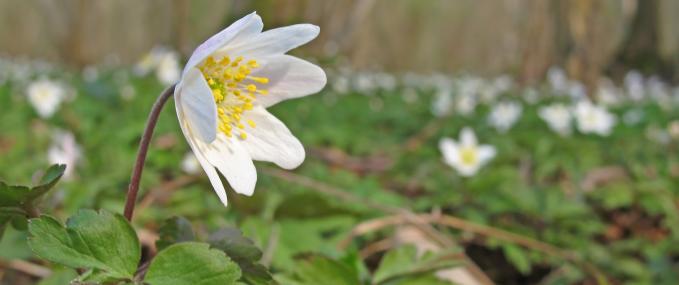Yellow Corydalis
Yellow Corydalis is a pretty yellow flower that originally came from the foothills of the Alps in southern Europe, but now grows wild in the UK often as an escapee from gardens. A shade-loving plant, it flowers from spring until mid-summer.
To encourage wildlife into your garden, try planting native flower species in your borders to provide a 'nectar-cafe' for bees and butterflies. But if you do prefer some non-native varieties, be careful when you throw away cuttings - species can easily escape into surrounding habitats and can cause problems for local wildlife. To find out more about wildlife-friendly gardening, visit our Wild About Gardens website: a joint initiative with the RHS, there's plenty of facts and tips to get you started.
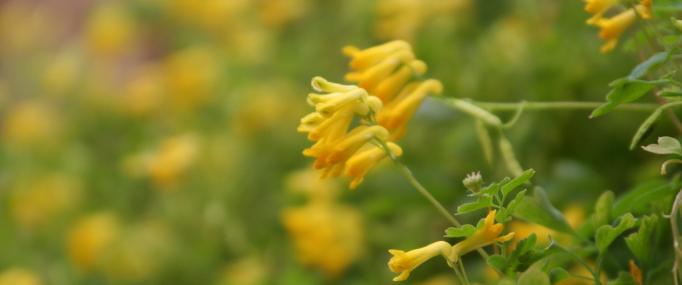
Fumitory
Common Fumitory is a common, scrambling plant growing in arable fields and on waste ground in the wider countryside, and favouring well-drained soils. It can also be found in gardens, where some gardeners view it as a weed.
Many of our so-called 'weeds' are beneficial to wildlife, providing food for nectar-loving insects and shelter for minibeasts. Try leaving wilder areas in your garden, such as patches of flowers like buttercups in your lawn and nettles near the compost heap, and see who comes to visit... To find out more about wildlife-friendly gardening, visit our Wild About Gardens website: a joint initiative with the RHS, there's plenty of facts and tips to get you started.

White Water-lily
The White Water-lily is a common plant of still or slow-moving water and grows in ponds, lakes, canals and ditches. It has large 'lily pad' leaves, up to 30cm across, and grows in water up to 5 metres deep, with the leaves floating on the surface. It flowers during the summer from June to August, the blooms opening up in the sunshine.
Human activity, including the drainage of land for agriculture and the loss of ponds through development, has resulted in the disappearance of many of the UK's wetlands. The Wildlife Trusts are working closely with planners, developers and farmers to ensure our wetlands are protected. You can help too: plant water-lilies and other natives in a wildlife-friendly pond and provide shelter for frogs and nectar for insects. In partnership with the RHS, The Wildlife Trusts' Wild About Gardens initiative can help you plan your wildlife garden.

Yellow Water-lily
The Yellow Water-lily is a common plant of still or slow-moving water and grows in ponds, lakes, canals and ditches. It has large 'lily pad' leaves, up to 40cm across, and grows in water up to 3 metres deep, with the leaves floating on the surface. It flowers during the summer from June to September, and smells like the dregs of wine, hence other common names like 'Brandy Bottle'.
Human activity, including the drainage of land for agriculture and the loss of ponds through development, has resulted in the disappearance of many of the UK's wetlands. The Wildlife Trusts are working closely with planners, developers and farmers to ensure our wetlands are protected. You can help too: plant water-lilies and other natives in a wildlife-friendly pond and provide shelter for frogs and nectar for insects. In partnership with the RHS, The Wildlife Trusts' Wild About Gardens initiative can help you plan your wildlife garden.
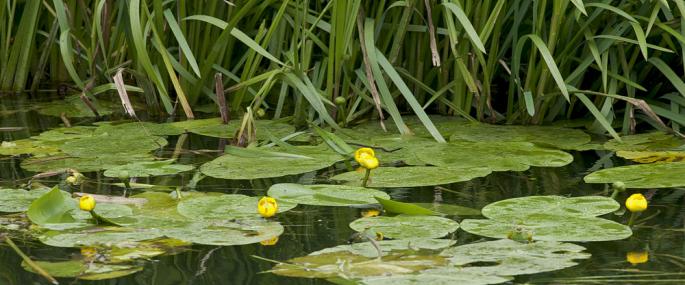
Greater Celandine
Greater Celandine is a tall plant of woodland rides, hedgerows, roadsides and waste ground. As a member of the poppy family, it is actually not a close relative of the Lesser Celandine which is a member of the buttercup family. Greater Celandine flowers from April to October.
Many of our so-called 'weeds' are beneficial to wildlife, providing food for nectar-loving insects and shelter for minibeasts. Try leaving wilder areas in your garden, such as patches of flowers like buttercups in your lawn and nettles near the compost heap, and see who comes to visit... To find out more about wildlife-friendly gardening, visit our Wild About Gardens website: a joint initiative with the RHS, there's plenty of facts and tips to get you started.
Yellow Horned-poppy
The Yellow Horned-poppy is a coastal plant which grows on shingle beaches, cliffs and sand dunes. The golden-yellow flowers appear in June and are followed by the 'horns' - curling seedpods that can be up to 30cm long. When it is broken, the plant exudes a yellow sap which is poisonous.
The Wildlife Trusts look after many coastal habitats for the benefit of plants like the Yellow Horned-poppy, and are working closely with farmers, landowners and developers to promote wildlife-friendly practices in these areas. We have a vision of a 'Living Landscape': a network of habitats and wildlife corridors across town and country, which are good for both wildlife and people. You can support this greener vision for the future by joining your local Wildlife Trust.
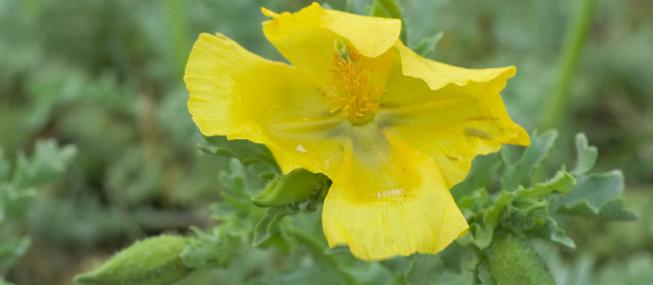
Welsh Poppy
The yellow Welsh Poppy is a perennial plant of damp, shady, hilly or rocky places, and is also found on walls and roadsides. It flowers from June to August and attracts pollinating bees and insects. It is an ideal plant to brighten up a shady corner in a garden.
The loss of many of our natural habitats in the countryside mean that the flowers and plants in our gardens provide vital food and shelter for a range of wildlife including butterflies, bees, birds and small mammals. To encourage wildlife into your garden, try planting native species such as the Welsh Poppy. To find out more about wildlife-friendly gardening, visit our Wild About Gardens website: a joint initiative with the RHS, there's plenty of facts and tips to get you started.
Poppy
Before the Second World War, arable weeds, such as the Common Poppy, would have peppered the landscape with colour in the summer months. But the post-war intensification of agriculture and widespread use of herbicides have driven these species to the brink of extinction in the wild. Nevertheless, The Wildlife Trusts manage many farmland and grassland habitats for the benefit of these plants, often using traditional methods. By volunteering for your local Trust you can help too, and you'll make new friends and learn new skills along the way.
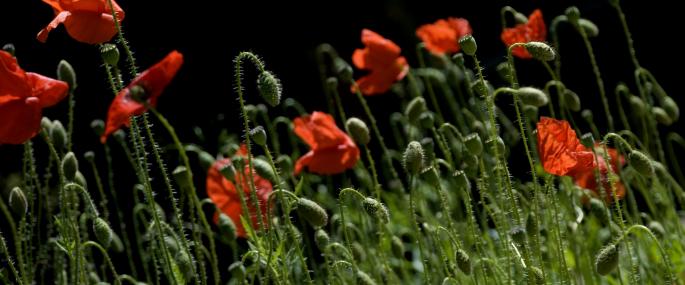
Pasqueflower
The pretty-in-purple Pasqueflower is now a very rare plant in the UK, restricted to just a few chalk and limestone grasslands and found on only a handful of nature reserves. It flowers in the spring, usually around April, its petals sitting cushioned on feathery leaves. Cloaked in myth, one legend has it that Pasqueflowers sprang up in places that had been soaked by the blood of Romans or Danes because they often appear on old barrows and boundary banks. However, it's more likely that these sites are favoured because they tend to be undisturbed chalk grassland.
The Pasqueflower is characteristic of chalk and limestone grasslands. Areas of rare and unique wildlife, chalk grasslands have been likened to rainforest for the diversity of species they hold. But they are being lost at an alarming rate due to changes in land use causing the decline of grazing: it's estimated that we've lost 80% of our chalk grassland over the last 60 years. The Wildlife Trusts manage many grassland nature reserves for the benefit of the rare wildlife they hold. You can help too: volunteer for your local Wildlife Trust and you could be involved in everything from scrub-cutting to stockwatching.
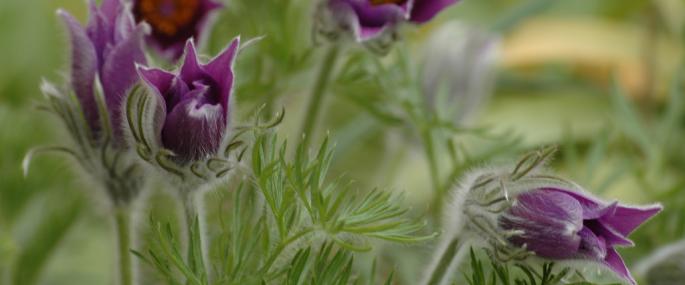
Wood Anemone
The Wood Anemone is a pretty spring flower of ancient woodlands, and is also planted in graveyards, parks and gardens. Its white flowers bloom between March and May before the canopy becomes too dense, but its seeds are mostly infertile and it spreads slowly through the growth of its roots.
The Wildlife Trusts manage many woodland nature reserves sympathetically for a range of spring flowers, from delicate Wood Anemones to showy Bluebells, golden Lesser Celandine to fragrant Ramsons. A mix of coppicing, scrub-cutting and ride maintenance open up the woodland floor to the sun, helping many flowers and plants to thrive. You can help too: volunteer for your local Wildlife Trust and you could be involved in everything from traditional forest crafts to raising awareness about woodland wildlife.
